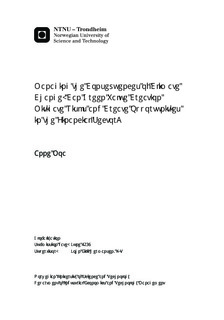| dc.contributor.advisor | Hermansen, John Eilif | nb_NO |
| dc.contributor.author | Moa, Anne | nb_NO |
| dc.date.accessioned | 2014-12-19T14:31:07Z | |
| dc.date.available | 2014-12-19T14:31:07Z | |
| dc.date.created | 2014-09-11 | nb_NO |
| dc.date.issued | 2014 | nb_NO |
| dc.identifier | 746136 | nb_NO |
| dc.identifier | ntnudaim:11642 | nb_NO |
| dc.identifier.uri | http://hdl.handle.net/11250/266899 | |
| dc.description.abstract | The current economic system is dependent upon constant growth and consumption to function, but the planetary boundaries are finite (UNEP 2013). The resulting climate change is likely to influence companies ability to do business in both positive and negative ways. The financial industry could be heavily impacted by the predicted consequences. This study seeks to identify the risks and opportunities that could arise as a result of climate change, and discuss whether the concept of green value creation could mitigate the risks and help companies reap the benefits. This study has looked aimed to answer the following research questions:1. How can green value creation in the financial sector be defined?2. Is green value creation present in SpareBank 1 SMN today?3. What risks and opportunities arise for the financial sector due to climate change?4. Can green value creation influence banks ability to manage changes that stem from climate change?5. Which measures can SpareBank 1 SMN implement to improve their green value creation?This has been a qualitative study of green value creation and the consequences of climate change on the financial sector. The research has been a case study of the large regional bank SpareBank 1 SMN. The information that is used was collected in two ways. The first was by doing a literature search for relevant academic literature on the topic of environmental sustainability in the financial sector. The second was through conducting interviews with the Executive Vice Presidents in SpareBank 1 SMN and the director of communications. Additionally, information gathered from a previous research project on stakeholder influence on CSR strategy in SpareBank 1 SMN was used as a supplement. The conclusion of this study is multifaceted. The research found that there is little green value creation in SpareBank 1 SMN today. The discussion showed that it was difficult to determine the impact of GVC on mitigating risk and benefitting from opportunities that arise from climate change because the topic is very complex. Several of the informants argued that they did not believe that it was possible to make a profit from providing green products and services to consumers, because consumers are not interested in it. Additionally, some of the informants argued that they did not believe that it was a part of the banks responsibility to bear the costs for influencing their customers in a green direction. Based on this, a number of measures are suggested to help SpareBank 1 SMN achieve a more responsible business model. This was done by targeting areas where the bank is most exposed to consequences of climate change, as for example in terms of risk management. | nb_NO |
| dc.language | eng | nb_NO |
| dc.publisher | Institutt for industriell økonomi og teknologiledelse | nb_NO |
| dc.title | Managing the Consequences of Climate Change: Can Green Value Creation Mitigate Risks and Create Opportunities in the Financial Sector? | nb_NO |
| dc.type | Master thesis | nb_NO |
| dc.source.pagenumber | 86 | nb_NO |
| dc.contributor.department | Norges teknisk-naturvitenskapelige universitet, Fakultet for samfunnsvitenskap og teknologiledelse, Institutt for industriell økonomi og teknologiledelse | nb_NO |

